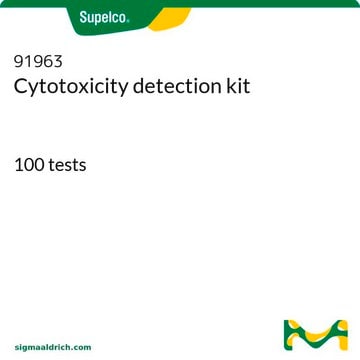MAK040
Adipogenesis Kit
sufficient for 100 colorimetric or fluorometric tests
Synonym(s):
Triglyceride Assay Kit
Sign Into View Organizational & Contract Pricing
All Photos(3)
About This Item
UNSPSC Code:
12161503
NACRES:
NA.25
Recommended Products
usage
sufficient for 100 colorimetric or fluorometric tests
detection method
colorimetric
fluorometric
relevant disease(s)
endocrinological disorders, diabetes; cardiovascular diseases; cancer
storage temp.
−20°C
General description
Adipogenesis is the differentiation of pre-adipocytes derived from pluripotent mesenchymal cells into mature adipocytes. Adipocytes, which are capable of storing large quantities of lipids as triglycerides, are the main cells for lipid storage in animals. Adipose tissue plays a critical role in the regulation of whole-body energy homeostasis and adipocyte dysfunction has been implicated in pathological states such as cancer, type II diabetes, cardiovascular disease, and atherosclerosis.
Omental adipocytes are known to promote the invasion and progression of cancer cells especially, ovarian cancer. Close proximity of tumor cells and adipocytes, causes a phenotypic change resulting in the formation of adipocyte-derived fibroblasts, which directly promotes tumor progression. Elevated level of adiponectin produced by adipocytes is observed in heart failure patients, cardiovascular disease, and atherosclerosis. Excess cytokines such as TNFα (tumor necrosis factor -α) in adipocytes results in chronic inflammatory state and inhibits the process of adipogenesis. Adipocytes are known to maintain glucose homeostasis. Adipocytes regulates the entry of fatty acids into circulation and skeletal muscle. This action of adipocytes is associated with the development of type 2 diabetes, which indicates insulin resistance as a result of high levels of fatty acids in the blood.
Omental adipocytes are known to promote the invasion and progression of cancer cells especially, ovarian cancer. Close proximity of tumor cells and adipocytes, causes a phenotypic change resulting in the formation of adipocyte-derived fibroblasts, which directly promotes tumor progression. Elevated level of adiponectin produced by adipocytes is observed in heart failure patients, cardiovascular disease, and atherosclerosis. Excess cytokines such as TNFα (tumor necrosis factor -α) in adipocytes results in chronic inflammatory state and inhibits the process of adipogenesis. Adipocytes are known to maintain glucose homeostasis. Adipocytes regulates the entry of fatty acids into circulation and skeletal muscle. This action of adipocytes is associated with the development of type 2 diabetes, which indicates insulin resistance as a result of high levels of fatty acids in the blood.
Application
Adipogenesis Kit has been used to study the intramyocellular triglyceride accumulation in myotubes. It has been used to study the effect of NS5ABP37 on hepatocellular carcinoma by determining the total intracellular triglyceride.
Suitability
Suitable for the quantification of triglyceride accumulation in cells and tissue
Principle
In this kit, total cellular and tissue concentrations of triglycerides are determined by a coupled enzyme assay, which results in a colorimetric (570 nm)/ fluorometric (λex = 535/λem = 587 nm) product, proportional to the triglycerides present. This kit is able to detect triglycerides in as few as 1 × 104 differentiated 3T3 L1 cells.
Signal Word
Danger
Hazard Statements
Precautionary Statements
Hazard Classifications
Eye Dam. 1 - Resp. Sens. 1 - Skin Sens. 1
Storage Class Code
10 - Combustible liquids
Flash Point(F)
188.6 °F - closed cup
Flash Point(C)
87 °C - closed cup
Certificates of Analysis (COA)
Search for Certificates of Analysis (COA) by entering the products Lot/Batch Number. Lot and Batch Numbers can be found on a product’s label following the words ‘Lot’ or ‘Batch’.
Already Own This Product?
Find documentation for the products that you have recently purchased in the Document Library.
A new role for the natriuretic peptides: metabolic regulators of the adipocyte.
Costello-Boerrigter L C and Burnett J C
Journal of the American College of Cardiology (2009)
Adipocytes promote ovarian cancer metastasis and provide energy for rapid tumor growth.
Nieman K M, et al.
Nature Medicine, 17(11), 1498-1498 (2011)
Adipocyte-Derived Fibroblasts promote tumor progression and contribute to desmoplastic reaction in breast cancer.
Bochet L, et al.
Cancer Research, 530-530 (2013)
Adipocyte dysfunctions linking obesity to insulin resistance and type 2 diabetes.
Guilherme A, et al.
Nature Reviews in Molecular and Cell Biology, 9(5), 367-367 (2008)
Chien-Liang Fang et al.
Frontiers in pharmacology, 9, 155-155 (2018-03-22)
The dermis of human skin contains large numbers of fibroblasts that are responsible for the production of the extracellular matrix (ECM) that supporting skin integrity, elasticity and wound healing. Previously, an in vivo study demonstrated that dermal fibroblasts siting in
Our team of scientists has experience in all areas of research including Life Science, Material Science, Chemical Synthesis, Chromatography, Analytical and many others.
Contact Technical Service







